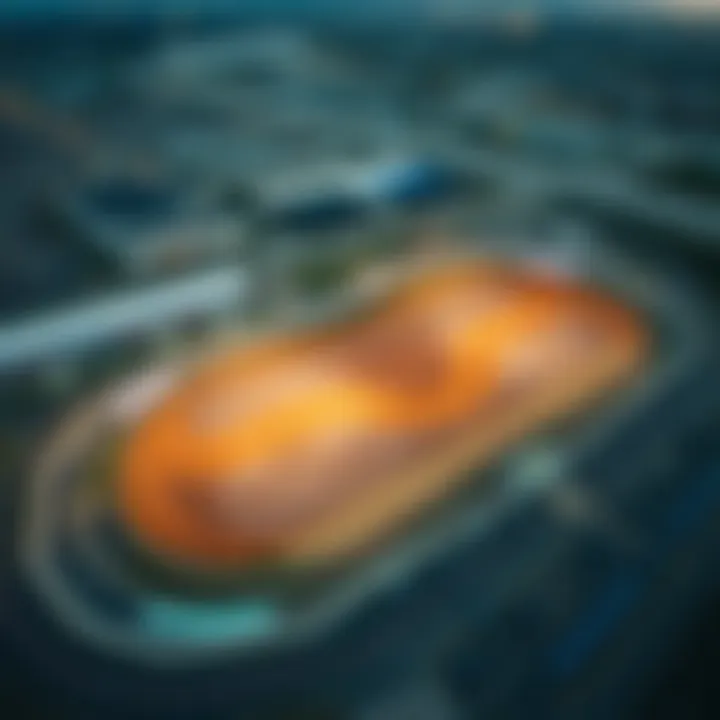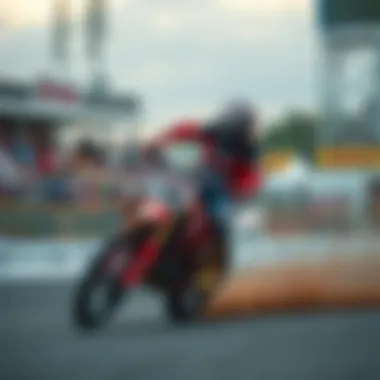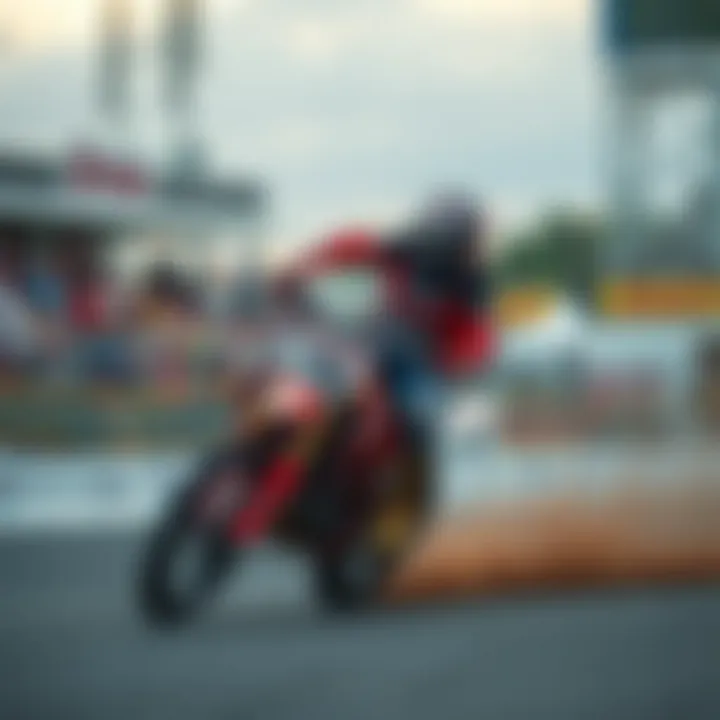The Daytona Speedway: A Motocross Epicenter


Intro
When one thinks of motorsports, places like Daytona International Speedway immediately spring to mind. However, alongside its storied history of NASCAR and stock car racing, it serves an equally exhilarating role as a motocross epicenter. With every roar of engines and the smell of burnt fuel, the speedway encapsulates the adrenaline-fueled spirit of motocross racing. This article dives deep into the thrills and intricacies of motocross at Daytona, shedding light on its fascinating history, technical nuances, competitive scene, and the aspects enhancing safety for riders navigating this rugged sport.
The History of the Sport
Origin and Evolution
Motocross, as some might argue, has roots that intertwine with off-road motorcycle racing in Europe. Originating in the UK during the early 1900s, the sport blossomed into various formats, each showcasing a rider's skill amid natural terrains. By the 1960s and 70s, motocross had taken off, and its popularity spread to the United States. Daytona Speedway entered the fray as a vital player, hosting its first major motocross event in 1971, marking a pivotal moment in American motorsport history.
Milestones and Influences
The Daytona Motocross event has seen numerous milestones over the years. For instance, it’s known for its unique combination of speedway and dirt track elements. This blend not only defines the nature of competition but also challenges riders, making the stakes higher. The annual Daytona Supercross event, held since 1971, showcases professionals' grit and the advancements in bike technology, techniques, and design. This competition stands out not merely for its legacy, but for its ability to adapt and influence the overall landscape of extreme sports.
Key Athletes and Pioneers
Many legendary riders have left their mark on Daytona’s motocross history. Names like Bob Hannah and Jeremy McGrath have become synonymous with excellence in the sport. Their triumphs at the speedway helped popularize motocross in the U.S., inspiring countless aspiring athletes. These pioneers represented a new era, seamlessly blending skill with sheer daredevilry, paving the way for future generations to follow.
Techniques and Skills
Basic Techniques for Beginners
Though motocross seems intimidating, harnessing a few foundational techniques can set a beginner on the right path. Key skills include mastering body positioning, learning to throttle effectively, and practicing controlled braking. Standing up on the pegs is essential, as it allows better maneuverability, especially when navigating rough terrains. A rigid stance can help absorb shocks from bumpy surfaces.
Advanced Skills to Acquire
As one progresses, mastering intricate skills becomes paramount. Techniques such as whoops navigation, cornering intricacies, and choosing appropriate lines through jumps often separate the novices from the pros. The ability to confidently leap across table tops or handle burms with precision can be the difference between podium finishes and mediocre placements.
Common Mistakes and How to Avoid Them
For newcomers, some typical pitfalls include overly aggressive throttle control and poor braking techniques. These can lead to loss of balance and crashes. A well-timed throttle application combined with a light grip on the bike ensures better control over the machine, while knowing when to brake steadily can prevent unnecessary spills. It’s crucial to practice these techniques until they become second nature.
Safety Measures
Essential Safety Gear
Safety is paramount in motocross, a reality emphasized regardless of skill level. Essential gear includes a DOT-approved helmet, goggles, gloves, knee braces, and sturdy boots. Some riders even opt for chest protectors and neck braces for added safety. Investing in high-quality gear not only protects against injury but also enhances overall performance.
Safety Practices and Procedures
Understanding the track and its nuances is critical for rider safety. Regularly checking equipment, understanding the layout of the course, and familiarizing oneself with emergency procedures are foundational practices every rider should adopt. Also, knowing how to spot essential track markers can drastically improve decision-making during a race.
How to Prepare for Unexpected Situations
No one can predict every outcome in motocross. Hence, preparation plays a crucial role. Anticipating potential hazards by observing fellow riders, honing mental resilience, and developing quick decision-making skills constitute vital preparation. Riders should also stay in prime physical shape to respond to unforeseen situations, enhancing both performance and safety.
Gear Recommendations
Top Brands and Products
When searching for motocross gear, several brands stand out, including Alpinestars, Fox Racing, and Thor MX. Each of these companies produces reliable and high-quality products tailored for the rigorous demands of the sport.
Budget vs. Premium Options
Investing in gear varies widely from person to person. There are excellent budget options available that still deliver decent performance and safety, such as Fly Racing and O'Neal. However, premium brands offer advanced materials and technologies, leading to better fit and durability. One must carefully weigh the options and consider frequency of use versus investment cost.
Maintenance and Care for Gear
Proper care for gear can prolong its lifespan significantly. Regular washing, ensuring suitable storage, and checking for damage after every ride are fundamental practices to maintain functionality. Keeping the gear clean from dirt and grime not only saves on future costs but ensures gear reliability when it matters most.
Culmination
The Daytona Speedway stands as an inseparable part of racing history while simultaneously embracing the electrifying realm of motocross. Its impact resonates deeply within the sport, reflecting both tradition and innovation. Embarking on this journey through the intricate world of motocross at Daytona offers riders and enthusiasts a comprehensive look, encouraging a continuous exploration of this thrilling sport.
Prologue to Daytona Speedway


The Daytona Speedway is not just a mere racetrack; it stands as an iconic landmark in the world of motorsports. Understanding its significance is key for anyone diving into the thrilling realm of motocross. The track serves not only as a competitive ground for racers but also as a cultural hub for fans and enthusiasts who converge here to witness high-octane action.
Historical Significance of Daytona
Daytona's roots run deep, tracing back to its inception in 1959 when it became a haven for racing aficionados. It rose to fame as the home of the prestigious Daytona 500, capturing the attention of millions around the globe. Over the years, the Speedway evolved, accommodating various racing events, including motocross, and solidifying its status as a legendary venue. The historical wood boards and the contrasts between past and present create a tapestry that enriches the spirit of each event held here.
Overview of Racing Events
The Speedway showcases a variety of racing events throughout the year, drawing a diverse crowd.
Types of Races
At Daytona, the types of races range widely from the adrenaline-pumping Motocross to NASCAR’s high-speed showdowns. This versatility contributes to its reputation as a multipurpose racing facility. Each type of race brings with it a unique flavor, making the venue a popular choice among various racing fans. The layout accommodates multiple formats—such as supercross, which features intricate obstacles—allowing riders to showcase their skills while keeping the audience on the edge of their seats. This variety is part of what makes Daytona such a special venue in the world of motorsports.
Annual Schedule
The annual schedule at Daytona is packed with thrilling events, ensuring there’s never a dull moment. Key races are strategically placed throughout the year, drawing attention from media and fans alike. Notably, the supercross event is a highlight, often held during the first half of the year. This timing aligns with school breaks, making it easier for families to attend. The crowded calendar not only keeps the racers engaged but also stimulates local businesses, generating an economic boost for the surrounding community. It’s a win-win situation that showcases the Speedway's pivotal role within the motocross community.
Motocross at Daytona Speedway
Motocross at the Daytona Speedway holds significant value in the world of extreme sports. It’s not only a venue; it’s a testament to the adrenaline-fueled culture that surrounds motocross racing. Known for its rich history and dynamic events, the Daytona Speedway provides a unique playground for both riders and fans. The track offers a blend of excitement, challenge, and spectacle, drawing in enthusiasts and curious spectators alike. In a sport where precision meets raw power, Daytona enhances the thrill with its thoughtfully designed course and atmosphere.
Track Design and Layout
Dimensions and Features
When it comes to the dimensions and features of the track, Daytona stands apart from typical motocross venues due to its expansive layout. Spanning 1.1 miles and featuring multiple jumps and banked corners, this track demands technical skills and a good sense of balance from riders. The sweeping turns and elevation changes put riders to the test, pushing their limits while offering glimpses of magnificence in every turn.
A key characteristic is the variety of obstacles that keep competitors on their toes. From thrilling tabletop jumps to sharp turns, each aspect is crafted to maximize both speed and challenge. This diversity in track features is a main reason why riders consider it a top-tier destination. However, the vastness can also be intimidating, especially to newcomers who might struggle to find their rhythm amidst such demanding features.
Surface Composition
The surface composition is crucial in shaping the racing experience at Daytona. The dirt track is packed with a unique combination of sand and clay, which offers excellent traction while ensuring durability. The blend allows for a smooth ride, contributing to safety while enhancing speed. A notable feature of this surface is its ability to hold up under different weather conditions; the rain doesn’t render the track unrideable. Instead, it allows for multiple racing lines, providing riders with options.
This adaptable surface composes a key element in competitive scenarios. However, it can lead to some dust issues in dry conditions, which may obscure visibility. Riders must learn to navigate that extra challenge, which adds an exciting layer to the race day experience.
Historical Races and Milestones
Notable Competitions
Daytona's reputation for hosting notable competitions is well-established. The Daytona Supercross, part of the AMA Supercross series, has gained a cult following and attracts the best riders year after year. This event not only marks an annual highlight but represents pivotal moments in the motocross calendar, often delivering unforgettable performances.
A key aspect of this competition is how it brings together world-class talent, leading to fierce rivalry and inspiring moments. The unique blend of skilled riders and an electrifying crowd creates an atmosphere that is hard to match in other locations. One can argue that such events solidify Daytona's status as the epicenter for motocross enthusiasts.
Record Holders
Records set at the Daytona Speedway serve as benchmarks for aspiring competitors. Names like Ryan Villopoto have etched their legacy in the annals of motocross history by achieving remarkable feats during competitions there. The importance of record holders extends beyond mere statistics; they embody the spirit of resilience and determination, inspiring future generations of riders.
Additionally, these record-setting performances often lead to more enhanced and competitive events. Knowing there’s a record to chase drives athletes to push their limits, resulting in thrilling performances that captivate audiences. However, with every record comes pressure, as future contenders aim not only to surpass the previous mark but also to redefine what is considered achievable in the sport.
Rider Dynamics in Motocross
Understanding Rider Dynamics in motocross goes far beyond the mere act of racing; it encapsulates the very essence of competition, growth, and the thrilling spirit of the sport. Rider dynamics encompass behavior patterns, interaction with the bike, and the rivalry that shapes the atmosphere of events, particularly at the Daytona Speedway. It’s these deep-rooted influences that make this sport as captivating as it is dangerous.
Key Rider Profiles
Profiles of Champions
When it comes to any moto sport, champions are not just participants; they are legends. Profiles of champions showcase the pinnacle of human skill and determination, often becoming benchmarks for future riders. Many of these champions have crafted their paths through sheer grit and talent, establishing themselves as iconic figures in motocross.
A key characteristic of these champions is their ability to adapt to various conditions, whether it’s the weather, track layout, or even their bike’s performance. This adaptability speaks volumes about their experience and training. In the context of this article, examining these profiles reveals invaluable lessons about what it takes to reach such heights in the sport. Being a champion at Daytona is not just about speed; it also involves strategic thinking and mental fortitude to navigate the challenges of one of the most demanding tracks in the world.
The unique feature of champion profiles lies in their backstories and struggles. While many may have achieved success, they've weathered storms, injuries, and fierce competition to secure their places in motocross history. This rich tapestry of experience provides complex narratives that inspire young riders and foster a connection between past and present. However, these popular figures also bring challenges, as the pressure to perform can lead to burnout or injury, reflecting the sport's dual nature of glory and peril.
Emerging Talents


While champions bask in their glory, emerging talents represent the future of motocross. The emergence of new riders injects fresh energy into the sport, often accompanied by innovative techniques and perspectives. These riders might not yet have the accolades to their name, but their passion shines through their performances at events like Daytona, offering glimpses of potential greatness.
A defining characteristic of emerging talents is their willingness to take risks. This willingness often sees them experimenting with techniques that seasoned riders may shy away from. This exploratory nature is beneficial in this article as it highlights the evolution of the sport. Moreover, their lack of a deeply ingrained fear of failure allows them to push boundaries and set new standards.
What makes these talents unique is their connection with fans. They are relatable, often coming from grassroots backgrounds, and their stories resonate with many aspiring riders. This connection can be a double-edged sword, attracting attention but also placing expectations on their shoulders. Nevertheless, the enthusiasm they bring keeps the sport vibrant and fosters an environment ripe for innovation.
Rider Training and Preparation
Fitness Regimens
In motocross, the need for fitness regimens cannot be overstated. Racing is a physically demanding sport that requires a unique blend of strength, endurance, and flexibility. Fitness plays a pivotal role in ensuring that riders can maximize their potential on the track. Tailored training programs of both champion riders and emerging talents often incorporate high-intensity workouts, cardiovascular training, and flexibility exercises specific to the requirements of motocross.
One notable aspect of these regimens is their focus on core strength. A strong core is crucial for maintaining balance on a bike, especially when tackling a difficult course like Daytona. This emphasis on fitness is crucial for this article as it underscores the rigorous preparations needed to compete at a high level. Additionally, a well-structured fitness plan can significantly reduce the risk of injuries, a common occurrence in such an extreme sport.
However, these training methods can have a downside as well. Many riders might prioritize fitness to the detriment of recovery or overlook mental training, which is just as critical. Balancing physical fitness and mental preparedness represents an ongoing challenge in the sport.
Technical Skills Development
Moving from physical preparation, we arrive at technical skills development. Becoming proficient in motocross is not simply about riding fast; it involves a comprehensive understanding of the bike and its mechanics. Riders invest countless hours honing their skills, focusing on different aspects from cornering techniques to jumps, which are integral to performing well.
One critical element of technical skills is the understanding of bike control. Riders need to anticipate every twist and turn of the track, often leaving little room for error. The driving characteristic of strong technical skills is evident in a rider's ability to remain calm under pressure, making quick decisions that can lead to success or failure in split seconds. Such insights are beneficial for our audience by illustrating what sets successful riders apart.
However, the quest for technical mastery can sometimes become overwhelming. Emerging talents may feel pressured to mimic the techniques of established champions, risking their own style in the process. This can interfere with the natural evolution of their skills, underscoring the importance of finding a balance between inspiration from the champions and the development of individual riding styles.
"In motocross, becoming a rider is not just about the victories; it’s about the journey and growth that come with each race." - A common reflection among aspiring motocross athletes.
Technical Aspects of Motocross
When we dive into the world of motocross, technical aspects are paramount. These characteristics can dictate not only a bike's performance but also a rider's safety. Understanding these elements enables both enthusiasts and participants to appreciate the intricacies that make motocross so compelling at the Daytona Speedway.
Motorcycle Specifications
Engine Types
The heart of any motocross bike is its engine, and knowing about different types is crucial. There are primarily two engine configurations used in motocross: two-stroke and four-stroke engines.
- Two-stroke engines are simpler and lighter, giving them a power-to-weight edge, which many riders adore for their high-revving nature. This type can deliver an exceptional power surge, making it advantageous for short, intense rides on tricky terrains.
- Four-stroke engines, on the other hand, are favored for their torque and smoother power delivery. These engines tend to offer better fuel economy and sustained power across longer periods, reducing fatigue during races.
In essence, whether a rider picks one over the other usually boils down to personal style and the unique demands of the race. The unique feature of the two-stroke's roar is undeniably appealing to some, while others appreciate the steadier approach of the four-stroke.
Suspension Systems
Suspension is another vital element, ensuring that riders can navigate the rugged tracks gracefully. The common types are spring and air suspension systems.
- Spring suspension systems maintain a consistent response to uneven terrains. Riders benefit from their reliability and consistency, as they can handle jump landings and rough patches without hesitation.
- Air suspension systems offer adjustability, which allows riders to fine-tune based on preferences or track conditions. This flexibility can provide a more customized ride experience, but requires meticulous adjustments and maintenance.
Various tricks and flips are undertaken at serious speeds; hence a well-optimized suspension is crucial to keeping the bike under control.
Safety Gear and Equipment
Protective Wear
For motocross enthusiasts, safety cannot be taken lightly. Protective wear, such as knee braces, chest protectors, and padded gloves, provides necessary safety, helping to absorb impacts from falls or collisions, which are all part and parcel of the sport.
A classic choice for many riders, the chest protector, helps shield vital organs. Its lightweight design makes it comfortable to wear while still providing essential coverage. In this high-speed environment of motocross, protective wear essentially acts as that safety net you hope you never need, but certainly, you'll be relieved it's there.
Helmets and Safety Regulations
Helmets are the crown jewels of motocross gear. Safety regulations around helmets often enforce that riders wear them at all times. A good helmet is vital, significantly reducing the risk of head injuries.
Modern helmets come equipped with advanced features such as MIPS (Multi-directional Impact Protection System), which is designed to reduce rotational forces during impacts. The unique aspect of helmets nowadays includes lighter materials that can withstand a serious blow without weighing down the rider.
The integration of high-tech materials in helmet design exemplifies the advancement in safety gear, but it’s essential to check the safety ratings before making a purchase. Just like a bread truck on race day, you might hope it’s not needed, but it certainly does the job well if you encounter an unfortunate twist of fate.
In summary, understanding the technical aspects of motocross enhances a rider's experience and directly correlates with their safety and performance on the track. The equipment, from the engine type to protective gear, plays a pivotal role in fostering an exhilarating yet secure environment in the heart of Daytona.


The Audience Experience
Understanding the audience experience at Daytona Speedway provides insights into why this venue is a cornerstone of motocross culture. Engaging a crowd goes beyond just watching a race; it's about creating unforgettable memories that linger long after the last bike has roared past the finish line. The vibrancy of the atmosphere, the interactivity with fans, and the economic ripple effects all play a significant role in framing the overall impact of the events held here.
Spectator Atmosphere
Viewing Areas and Accessibility
The viewing areas at Daytona Speedway are thoughtfully designed, balancing accessibility with an exceptional vantage point for fans. One standout characteristic is the elevation of the grandstands, which allows spectators to bask in high-octane action without a hindrance. This elevation acts like a double-edged sword; while it offers a strategic outlook over the track, it also means that those with mobility challenges might find navigation a touch tricky. There are designated access points and seating provisions that cater to diverse needs, making the event a more inclusive experience overall. The best part? The proximity of the stands to the track makes every roar of the engine and spray of dirt feel like a personal encounter.
Fan Engagement Activities
Delving into fan engagement activities, Daytona never falls short in stirring enthusiasm. From meet-and-greets with riders to interactive exhibits showcasing motorcycle tech advancements, the activities offer a rich tapestry of experiences. A particularly engaging feature is the pit tours, allowing fans to see behind-the-scenes mechanics and strategies. However, it’s worth noting that popular activities can lead to long lines during peak times, which might test the patience of even the most ardent fans. Still, for those eager to dive deeper into the world of motocross, these engagements add another layer to the adrenaline-soaked environment.
Economic Impact of Events
Local Business Involvement
When discussing local business involvement, the economic ecosystem surrounding Daytona Speedway comes into sharp focus. Local eateries and hotels actively prepare to welcome throngs of spectators, often tailoring services—like special menus or discounted packages—for event days. This partnership between the racetrack and local enterprises fosters a win-win situation where businesses thrive while simultaneously enhancing the event's ambiance. A notable downside, however, can be the occasional price hikes that emerge during high-demand days, which might deter some fans from enjoying the full Daytona experience.
Tourism Contributions
Tourism contributions stemming from events at Daytona are nothing short of remarkable. Visitors flock from various states and countries, enriching the local scene with diverse culture and spending. This influx leads to a significant boost in tourism revenue, with activities extending beyond the track to nearby attractions, such as the beach or local museums. A key characteristic lies in the seasonal nature of this tourism; fluctuations in visitor numbers can be dramatic depending on the racing calendar. While off-peak periods may see a dip in activity, the collective buzz during main events brings life and vibrancy to the region.
"The Daytona Speedway isn’t just a race track; it's a festival of speed, noise, and culture, fueling the local economy and enticing adrenaline junkies from around the globe."
In reflecting on the audience experience, a marriage of accessibility, engagement, and economic vibrancy creates a unique environment that enriches not just motocross but the community at large.
Future of Motocross at Daytona
As motocross continues to soar in popularity, the future at Daytona is becoming a hot topic of conversation among fans and professionals alike. With every twist and turn of innovation, the venue stands poised to adapt and enhance the motocross experience. Factors like technological advancements and changing competitive dynamics are critical to shaping what comes next. By seizing these opportunities, Daytona can bolster its reputation as a premier motocross destination while embracing new riders and enthusiasts.
Technological Innovations
Advancements in Bike Technology
The evolution of bike technology has become a pivotal factor in racing performance at Daytona. From the engines to the frames, the innovations are astonishing. New materials such as lightweight carbon fiber and stronger aluminum alloys make bikes faster and more responsive. This leap in bike design has taken off, as riders crave the edge that these machines provide.
One key characteristic of advanced bikes today is the fuel-injection systems that allow for real-time performance adjustments, improving both speed and fuel efficiency. This aspect is not just beneficial but essential, especially during grueling races where every second counts.
Moreover, electronic systems like traction control have also found their way into motocross, granting riders better handling in slippery conditions. This unique feature can be both a blessing and a crutch. Riders who become overly reliant on technology might struggle to adapt when conditions change abruptly. However, using tech wisely can yield tremendous advantages, keeping the competition fierce and unpredictable.
Improvements in Track Conditions
An equally vital element in revolutionizing motocross at Daytona is the ongoing improvements in track conditions. Over the years, advancements in ground-surface technology have led to better drainage systems and consistent terrain. This is particularly important in a place known for unpredictable weather, as a well-maintained track can be the difference between a safe race or a chaotic one.
One major aspect of these improvements is the use of synthetic materials in track construction. Tracks that utilize these materials can retain moisture while resisting the impact of wear and tear, leading to a smoother ride for the racers. As a result, the surface remains consistent, offering less chance of injury due to unexpected bumps or ruts.
The challenge, however, lies in maintaining these surfaces. As conditions change, the track requires constant upkeep to meet riders' demands. Investing in high-quality materials and expert maintenance can prove costly but pays dividends in rider safety and performance, making it a worthy pursuit.
Evolving Competitive Landscape
New Formats of Races
The motocross scene at Daytona isn't just about who can ride the fastest. It's evolving into a carnival of competition with new race formats that inject excitement and unpredictability into events. For example, the introduction of team races in certain events encourages collaboration among riders, expanding the sport's appeal beyond individual achievement.
Unique to Daytona are race formats that include night events, capitalizing on Florida’s balmy evenings. Night racing presents an entirely different challenge for competitors, from navigating light changes to adjusting on the fly with enhanced technical skills. The thrill of night racing captivates audiences, displaying not just speed, but strategy and adaptability.
This innovation not only captures a broader audience but also invites different competitors, enriching the sport's competitive fabric. Yet, the added complexity can deter younger and less experienced riders, potentially limiting participation unless adequate support systems are in place.
Potential for Increased Participation
With the sport's growth trajectory, the potential for increased participation is bright. More youth programs are popping up, which feed the next generation of motocross stars. Daytona’s commitment to accommodating these budding riders through training camps and amateur races lays the groundwork for expanding the sport's fanbase.
One notable characteristic of this trend is the increasing accessibility of motocross. With more affordable bikes and equipment available, aspiring bikers can jump in without breaking the bank. This accessibility encourages diverse participation, leading to an enriched racing community that reflects various backgrounds and skill sets.
However, the surge in participants can lead to crowded events, putting pressure on organizational resources. Managing these larger fields effectively must become a key focus for track administrators to ensure a smooth and fair competition.
The trajectory of motocross at Daytona is marked by innovation and adaptation. Embracing technological advancements and evolving race formats is crucial for sustaining interest and participation in this thrilling sport.
In summary, the vitality of motocross at Daytona hinges on these technological and cultural shifts. By engaging with new ideas and welcoming more participants, Daytona serves not just as a racetrack but as a pivotal player in the future landscape of motocross.







